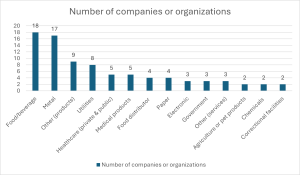September 2025
Inside the Newsletter:
Leaf Maintenance | Industrial Chloride | MnTAP Internships’ | Events | Funding Opportunities
Fall Leaf Maintenance for Landscapes and Ponds
Before the rainbow of fall foliage peaks, it is good to have a quick reminder on how to appropriately manage fallen leaves. In most communities, storm sewers are a direct channel for leaves on properties and streets to end up in local lakes, streams, and creeks. Decomposed leaves in our water systems can lead to algae blooms and cloudy water that block aquatic plants’ ability to photosynthesize. Fortunately, a University of Wisconsin study found that prompt and efficient disposal of leaf litter from streets and other impervious surfaces can lead to 80% reduction in phosphorus concentrations. This article will review effective practices for leaf maintenance on land and ponds as part of commercial landscaping.
Leave on lawns, mulch, compost, or bag?
There is no one-size-fits-all approach to fall leaf management as it depends on one’s landscaping goals. However, common ecofriendly practices include leaving leaves intact on the landscape, mulching leaves, or bagging leaves to dispose at yard waste drop-off sites if available.
- Leave intact leaves on lawns or areas with soil. The same nutrients from leaves that can cause harm in water bodies could be beneficial for soil health. Some businesses and organizations choose to leave fallen intact leaves as free fertilizer and habitats for wildlife like bees, earthworms, and butterflies. Here are three helpful tips.
- Avoid raking or blowing leaf piles onto the street. Remove leaves falling on paved parking lots, sidewalks, and other impermeable surfaces.
- Rake leaves into specific leaf piles over soil, lawn, or plants to allow leaves to break down naturally, provide natural habitat, and avoid collecting in stormwater runoff paths.
- Rake or move leaves onto flower beds and landscaped areas to benefit plants, especially perennial plants. These intact leaves can improve soil moisture and temperature regulation while protecting against soil compaction, weeds, or erosion.
- Mulching. If fallen leaves are prone to thick matting that block oxygen and lead to lawn disease, then consider mulching or shredding leaves. Shredded leaves can be left on lawns or applied to garden or flower beds and other areas that could use fertilizer. Here are two helpful tips.
- For those using traditional mowers, set them to the highest setting and be prepared to pass over fallen leaves at least twice to cut them down to size. Alternatively, businesses may consider buying a mulching kit to outfit a lawn mower to handle higher leaf piles at a time and/or in one pass. Mulching kits are relatively inexpensive and cost between $100 to $300.
- In areas with heavy leaf fall, mulch leaves at least twice a week.
- Compost onsite. Raking leaves into a compost pile is an excellent option to protect water bodies downstream while also providing nutrient-rich compost for landscaping. Here are 2 helpful tips.
- Check local municipal compost ordinances and requirements for businesses and organizations before starting to compost.
- Create healthy environments for bacteria to break down old leaves. For instance, create three to four-inch layers of brown leaves next to one-inch layers of green material (e.g., fruit or vegetable scraps, coffee grounds, and lawn clippings) and turn compost regularly.
- Bag to dispose at commercial yard waste disposal or yard waste drop-off sites. Depending on one’s location, the neighborhood might have disposal sites available for businesses to bring fall leaves that have been bagged. Visit the local municipality’s website to check availability of commercial or public disposal sites (website for Hennepin County; website for Ramsey County).
- Do not burn leaves or bag leaves in plastic bags for the trash. Finally, many communities have local bans against burning leaves, and burning leaves contributes to bad air quality for all. Minnesota State law also forbids putting leaves and other yard waste into regular trash as these are harmful to landfill and waste facilities.
Since many of these options may include raking leaves, it might be helpful to know that the best conditions for raking leaves are during calm, windless days, and raking dry leaves will be easier than raking wet leaves after rainfall.
Leaf maintenance for commercial ponds
Ponds and other large-scale water features can make a commercial business or organization look more inviting and aesthetic while providing habitats for fish, wildlife, and aquatic plants. However, excessive falling leaves can damage pond ecosystems and lead to algae buildup during warmer autumns. For businesses and organizations with water features, here are some helpful tips for fall maintenance.
- Routinely inspect and clean pond skimmers. For properties with pond skimmers, it might be helpful to check them at least three times a week during the fall to ensure that leaves are not clogging them.
- Reduce fallen leaves on ponds. A net or wet vacuum could clean up leaves that have already fallen on the pond surface before leaves can sink to the bottom or clog a pond skimmer. For ponds with fish and other animals, it might be helpful to install a leaf net over the pond to catch leaves before they can fall into the water.
- Routinely scoop out sludge from the bottom of the pond. Decaying leaves can form sludge on the bottom that also provides nutrients for algae growth. Potential tools for removing this sludge include long-handled pond nets, biological treatments, or vacuums. Adding aquatic plants, like water lilies, could also help absorb excess nutrients.
Effective leaf management helps businesses maintain healthy and attractive landscapes while protecting rivers, streams, and lakes for everyone to access. Fortunately, there are many helpful and relatively easy tips to help businesses and organizations manage leaves this fall.
Author
Jocelyn Leung
Communications Specialist
Launch of Industrial Chloride Reduction Project
 High levels of chloride negatively impact aquatic life in rivers and lakes in MN. It only takes one teaspoon of table salt to pollute five gallons of water above the chronic level of 230 milligrams per liter (mg/L). In 2024, 68 water bodies in Minnesota were on the Minnesota’s 2024 Impaired Waters List as impaired by chloride. Chloride enters water bodies as runoff from winter maintenance, fertilizer, and dust suppression or in discharge from wastewater treatment plants (WWTPs) and industrial facilities. With increasing chloride levels, chloride limits in wastewater permits are becoming more common, meaning WWTPs and industrial facilities need to reduce chloride discharge.
High levels of chloride negatively impact aquatic life in rivers and lakes in MN. It only takes one teaspoon of table salt to pollute five gallons of water above the chronic level of 230 milligrams per liter (mg/L). In 2024, 68 water bodies in Minnesota were on the Minnesota’s 2024 Impaired Waters List as impaired by chloride. Chloride enters water bodies as runoff from winter maintenance, fertilizer, and dust suppression or in discharge from wastewater treatment plants (WWTPs) and industrial facilities. With increasing chloride levels, chloride limits in wastewater permits are becoming more common, meaning WWTPs and industrial facilities need to reduce chloride discharge.
MnTAP is launching a project to help industrial facilities across Minnesota reduce chloride use to prevent chloride pollution. MnTAP will work directly with industrial facilities and coordinate with WWTPs to reach upstream facilities. One goal of the project is to reduce 25,000 pounds per year of chloride use, which would prevent pollution of 15,000,000 gallons of water. Project activities will include:
- Outreach: Direct outreach to communities and facilities about the project.
- Site assessments: MnTAP staff completing site visits to identify and quantify opportunities to reduce chloride use.
- Intern projects: Placing MnTAP interns on-site for 3 months to find ways to reduce chloride use.
- Sharing results: Sharing project results and lessons learned through presentations, success stories, a webinar, and a webpage.
If you are interested in learning more about the project or would like a meeting with MnTAP to discuss chloride at your facility, please contact Laura Sevcik.
Contact:
Laura Sevcik
lsevcik@umn.edu
612-624-8192
Reflection on MnTAP Internships’ Reach and Influence on Current and Past Interns
 On August 20, 17 MnTAP interns presented on their recently completed summer projects while the MnTAP intern program celebrated its 40th year anniversary. Momentous occasions like these present opportunities to consider the program’s impact and influence over the years. As John Dewey noted, “We do not learn from experience. We learn from reflecting on experience.” This article will first briefly review what sectors MnTAP interns have assisted over the past six years. It will then share two common insights made by three former interns (i.e., Olajumobi Akeeb, Madison Best, and Denzel Bibbs) that echoed what the 2025 cohort observed on their personal growth and shift in perspectives from participating in internships.
On August 20, 17 MnTAP interns presented on their recently completed summer projects while the MnTAP intern program celebrated its 40th year anniversary. Momentous occasions like these present opportunities to consider the program’s impact and influence over the years. As John Dewey noted, “We do not learn from experience. We learn from reflecting on experience.” This article will first briefly review what sectors MnTAP interns have assisted over the past six years. It will then share two common insights made by three former interns (i.e., Olajumobi Akeeb, Madison Best, and Denzel Bibbs) that echoed what the 2025 cohort observed on their personal growth and shift in perspectives from participating in internships.
Reach of MnTAP interns
From 2020 through 2025, 99 MnTAP interns have worked in a wide variety of organizations and industries. Graph 1 shows the different sectors where MnTAP interns have worked at.
Graph 1. Internship placement over the past 6 years
Background on interview process with former interns
Since the majority of MnTAP internships have taken place in manufacturing, it is unsurprising that many MnTAP interns have gone on to pursue careers in engineering and manufacturing. MnTAP staff were interested in re-connecting with some former MnTAP interns that now work in mainstream engineering and manufacturing roles to learn more about how their internships prepared them for their current roles and if they continue to practice sustainability in their day-to-day work.
Two MnTAP staff carried out interviews over Zoom during February 2025. One MnTAP staff transcribed the recorded interviews, coded the interview transcripts, and analyzed the data on Excel to develop themes that formed the findings in this article.
Key findings from conversations with three former MnTAP interns
Two findings that echoed what MnTAP interns expressed during the 2025 Symposium emerged from these interviews.
- MnTAP internships helped students develop into well-rounded professionals with technical and interpersonal skills.
- The MnTAP internship was a formative experience in introducing former MnTAP interns to new viable career paths.
MnTAP internships helped students develop into well-rounded professionals with technical and interpersonal skills.
All three interviewees reported learning how to solve technical problems to find more sustainable solutions. This translates into being analytical, knowing how to carry out research online, navigating technical resources, and asking the right questions to staff on the production floor. Asking questions in turn requires identifying what information is currently missing and acquiring technical expertise to fully understand the answers staff give to their questions.
Several interviewees delved into how this internship helped them envision solving problems on a larger scale. One interviewee talked about working on more technically complex problems associated with large machinery that could take up an entire room or building. The internship encouraged them to understand how the smaller parts that make up the large machinery interacted with each other. Another interviewee discussed how their internship has given them a useful lens to solve problems by seeing the big picture before focusing on the little things that can be adjusted.
In addition, multiple interviewees pointed out how this internship helped them be more self-reliant when walking across a facility and identifying areas for improvement or sustainability opportunities. This came from practice during the MnTAP internship along with shadowing MnTAP staff as they performed walkthroughs around factory floors. All three interviewees shared how working at MnTAP internships prepared them to collaborate with full-time professionals, including coworkers and external stakeholders (e.g., clients) that companies work with. During the internship, they learned how to show up at meetings, understand professional norms, and lead in project management.
“There are professional norms on what to communicate over email versus phone in a professional setting. We need to build an understanding of which communication method is appropriate and would be the most effective for the issue at hand. The MnTAP internship allowed me to go through more repetitions of that in determining which method of communication to use along with practicing how to initiate communications.”
Several interviewees reported translating what the client or staff had in mind into implementable solutions and clearly articulating the benefits of sustainability through tangible metrics (e.g., carbon dioxide reduction or less material ending up in the landfill) to convince people to implement their solutions. One interviewee discussed how the internship helped them discover that they were not only capable of persuading skeptical staff to try new water efficiency strategies, but also, they found this experience rewarding and wanted to continue practicing this skill in future roles.
The MnTAP internship was a formative experience in introducing interviewees to new viable career paths.
One commonality all interviewees shared was how working in a company through the MnTAP internship helped them better understand what career interests and strengths they had, and this was beyond what they could learn in a classroom. The MnTAP internship exposed all interviewees to careers that were new to them and eventually became their current careers.
“After I started the project and looked things up, it was like, “Oh, this makes sense. This is what I want to do.” It clicked for me. That’s how I knew that even if I was still interested in going to graduate school to do research after I graduated from that program, energy efficiency was what I wanted to do. I didn’t know where or how, but the internship was what did it for me. MnTAP helped me figure out what I wanted to do with my life basically.”
&
“This was the first time I had worked in a factory and specifically food manufacturing. This MnTAP internship really drove me to seek out similar roles after graduation, and it helped me determine what type of work environment I could really thrive in and be excited to go to work each day. Even today, I continue to work in manufacturing.”
For one interviewee, the MnTAP internship changed their perception that engineering could only be “heavily design and technical based” after being introduced to project management in construction. They learned that they wanted to work full time in managing workflows and gathering information to determine which technical opportunities are worth pursuing.
Conclusion
Like this year’s MnTAP interns, the three interviewees articulated how their internships led them to develop new skills, understand themselves better as professionals, and find career interests that they would not have been able to obtain through their classes. While many of these skills involved sustainability and conservation principles, they also practiced complex problem-solving, diagnosing issues and coming up with solutions through research and asking questions, and project management. Skills that can be applied universally and benefit employers at their host site and beyond. In addition, they explored fields and roles beyond what they envisioned was possible as students, and this demonstrates that the MnTAP internship could be a valuable talent pipeline for employers interested in identifying and nurturing interns to take on tasks and develop organizational knowledge for future hiring needs.
If you are a company interested in reaping the multifaceted benefits described above from participating in a MnTAP internship, learn more about the program here. This program is also accessible for smaller to medium-sized businesses with an affordable cost share (i.e., $4,000) and realistic expectations (e.g., 3 to 5 hours of supervision for the first 2 to 3 weeks of onboarding that typically drops down to 1 to 3 hours per week for the rest of the project) to host an intern.
For questions on all aspects of the MnTAP Intern Program, please email or call Matt Domski.
Author
Jocelyn Leung
Communications Specialis
Contact:
Matt Domski – Intern Program Manager
mdomski@umn.edu
612-624-5119
Events
Smart Salting: Parking lots and sidewalks certification training
MPCA
Event 1: October 9, 2025 at Empire Transportation Facility, 2800 160th St W, Rosemount (8-1:30 pm)
Event 2: October 14, 2025 at Mississippi Watershed Management Organization, 2522 Marshall St NE, Minneapolis (8-1:30 pm)
Event 3: October 22, 2025, virtual (8-1:30 pm)
No Cost
Audience: Private winter maintenance companies and city park, hospital, and school winter maintenance professionals. Participants will learn how to integrate science with practical winter maintenance while minimizing impacts on the environment. Upon completion of training and passing the test issued at the end of training, you will earn a Smart Salting certification that expires five years from the date of training.
Smart Salting: Property Management certification training
MPCA
October 7, 2025, 9:00-1:30 PM
Virtual, No Cost
Audience: Property managers, environmental professionals and advocates, business owners, those who hire private winter maintenance professionals, MS4 and Wastewater permit staff, and public works directors or other high-level management roles. Participants will learn how to reduce damages caused by salt, how reducing salt use can save money while providing safe surfaces, ways to encourage your maintenance crew to use sustainable practices, how to address liability concerns, and the basics of snow and ice management tools. Upon completion of training and passing the test issued at the end of training, you will earn a Smart Salting certification that expires three years from the date of training. Register at this link.
Ramsey County Hazardous Waste Training
Ramsey County
October 9, 2025, 9:00-12:00
In-Person, No Cost
Smart Salting: Roads certification training
MPCA
October 28, 2025
Virtual, No Cost
Audience: City, county, or state winter maintenance professionals. Participants will learn how to integrate science with practical winter maintenance while minimizing impacts on the environment. Upon completion of training and passing the test issued at the end of training, you will earn a Smart Salting certification that expires 5 years from the date of training. Register at this link.
Funding Opportunities
- Greater MN waste reduction, reuse, recycling, and composting grants (MPCA): Deadline is 4:30 pm CT on October 7, 2025 through SWIFT Supplier Portal.
- Freight switcher locomotive grant (MPCA): Deadline is 4:00 pm CT on October 22, 2025.
- Environmental assistance loans for capital costs associated with environmental processes and technologies (MPCA & private financial institutions)
- Small business environmental improvement loans [0% interest for capital equipment purchases] (MPCA)
- Funding for brownfield investigation (MPCA)
- Clean Water Partnership loans (MPCA): Second tier loans allow local entities to make loans to landowners and other stakeholders.
- Business Pollution Prevention Program [Up to $50,000 or up to 75% of project costs] (Ramsey/Washington Recycling & Energy and MN Chamber of Commerce Waste Wise): Consider this opportunity if your business uses or produces any of the following chemicals with volatile organic compounds (VOCs); perchloroethylene (PERC); trichloroethylene (TCE); ground level ozone; fine particulate matter (PM2.5); or hazardous air pollutants (HAPs).
- Safety Grant Program [Up to $10,000] (MNOSHA WSC): For projects designed to reduce risk of illness or injury to their employees. Applications are reviewed in two-month intervals.

